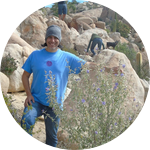About This Project
Mycorrhizal communities are a fundamental mutualistic interaction between soil fungi and trees. However, the interaction between soil bacteria and mycorrhizal fungi is vastly unknown. Since these microorganisms have fundamental roles in carbon and nitrogen fixation, we would implement a biosensor device to assess the spatiotemporal distribution of mycorrhizal-bacterial species and how their diversity and abundance affect trees grown in challenging environments.
Ask the Scientists
Join The DiscussionWhat is the context of this research?
Previously, a similar signature of carbon-13 and nitrogen15 isotopes accumulated in ecto and ericoid mycorrhizal communities of deep soil strata from boreal forest soil. This isotopic concentration is comparable to aerial parts (leaves). In differential successional stages, Streptomyces AcH505, a mycorrhiza helper bacteria (MHB) has been associated with the differential expression of carbon metabolism, cell signaling, and cell division genes in A. muscaria. This observation suggests that MHBs have a role in controlling the hyphae growth and plant biomass increase of associated mycorrhizal communities.
What is the significance of this project?
As Abies trees approach maturity, we expect to observe variations in either the mycorrhizal-MHBs composition and/or expression levels linked with carbon capture metabolism in either isolated fungi species in the field and compare them to samples from trees observed under a controlled environment (greenhouse). This information could be crucial to understanding the underlining mechanisms regulating carbon capture in challenging environments such as those affected by drought and air pollution. One of our objectives is to elucidate the interplay of the molecular mechanism that could define ecological aspects of mycorrhizal and bacterial interactions.
What are the goals of the project?
Understand how the genome of rhizosphere mycorrhizal communities is modulated by MHBs in forestal species (Abies sp) impacting carbon sequestration metabolism. 3D printed microfluidic chips equipped with CO2 and humidity sensors will monitor soil respiration in the surrounding soil of Abies trees of different growth stages while capturing ectomycorrhizal fungi and MHBs. The microfluidic chip will mimic the microenvironment of the mycorrhizal and bacterial populations. Once completed, the devices will be planted in open Abies cultivars and controlled greenhouses, to follow their performance over 4 to 6 months. Isolated mycorrhizal and bacterial samples will be submitted to sequencing for ID and metabolic profiling.
Budget
We will deploy remotely controlled devices that will collect mycorrhizal samples to measure their density and diversity. It requires the design and construction of environmental-proof microcontrollers and sensors. The devices will provide continuous information on the rhizosphere environmental variables through cell/LoRa communications. Rapid, DNA sequencing of remote area samples will be required to ID the collected species and their abundance. Specific microfluidics devices will be designed to manage the soil samples. The area of study will comprise commercial and protected areas where Abies trees or related species are grown in Eastern USA (NJ) and central Mexico.
Endorsed by
 Project Timeline
Project Timeline
The first stage entails creating 3D-printed microfluidic devices that are connected to sensors that monitor various environmental factors, such as CO2, temperature, humidity, conductance, etc. The devices should withstand the field's environmental conditions while catching MHBs in developing young Abies threes. Samples will be taken at various points in the process. Mycorrhizal groups and MHBs can be identified using genetic profiling.
Mar 08, 2023
Project Launched
Mar 31, 2023
Microfluidic device assembly/LoRa: 3D printed devices will be coupled to a wireless communication system for sending environmental information where samples will be extracted.
Apr 30, 2023
Deployment of sensors: The devices will collect information on the changing conditions of the soil environment while promoting the colonization of MHBs.
May 12, 2023
Project Launched
Jun 01, 2023
DNA extraction and ID of species and metabolic routes: Microbial DNA will be sequenced to ID the species abundance and diversity ratios.
Meet the Team
Affiliates
Affiliates
Team Bio
Gregory Merritt., B.Sc. International Affairs, Georgia Institute of Technology. GA, USA; B. Sc Microbiology, University of Victoria, B.C. Canada; 11 years in the US Navy, conducted maritime tracking/fixed-site correlation using geospatial analysis tools.
Whaleeha Gudiño Ph.D., Ecophysiology Botanist with expertise in anatomical and functional performance in cacti and the atmospheric relationship between climate and plants development
David J. Castillo
Biomedical researcher with extensive experience in the Biophysics of nanomotors, and nanotechnology applications in soft matter. Specialist in molecular microbiology tools and single particle analysis (genomics, molecular biology, optical microscopy, biochemistry, protein engineering, and plant development. Trained undergraduates, graduate students, and postdocs in several scientific research institutions in Mexico, USA, Germany, and Japan, (UNAM, Arizona State University, Max Planck Institute, Osaka University, and Waseda University).
External analyst for environmental assessment in urban ecosystems using multispectral images on UAVs (drones) designed remotely operated biosensors and integration into GIS for environmental modeling, in collaboration with NGOs, civil organizations, and local governments and Environment Secretariats (SEDEMA, CONAFOR, PAOT).
GLYXON Biolabs DIY Biospace for biomaterials. Founder and director
Glyxon Biolabs studies micro-algae, plants, and bacterial models to explore further strategies of atmospheric CO2 sequestration and biopolymers biosynthesis by combining biotechnological approaches and computer-based simulations of ecological dynamics of planktonic ecosystems and bacterial consortia. Our interests include microfluidics; 3D printing cell cultures; biopolymers biosynthetic pathways; simulation of genetic chassis circuits; gene editing and protein engineering in bacterial models and plants; Lab automation using microcontrollers and tailored integrated circuits.
Former Research Scientist at Arizona State University, Biodesign Institute's Center or Mechanism of Evolution, studying single-cell mechanotransduction in bacterial models involved in motility and molecular nanomotors.
He is back in Mexico City, working as director and lead researcher at Glyxon Biolabs, focused in modulation of cell differentiation in unicellular organisms using bacteria, algae and plants.
Gregory Merritt
2002 B.s. International Affairs, Georgia Institute of Technology. GA, USA
2022 (June) University of Victoria, B.C. Canada, Bachelor’s Degree in Microbiology
Experience:
Eleven years in the US Navy, providing situational awareness at a tactical and operational level.
He conducted both shipboard electronic warfare operations and maritime tracking/fixed-site correlation using geospatial analysis tools.
Relevant skills:
-Maritime analysis and mapping - Three years conducting maritime tracking and fixed-site correlation analysis tools within the
GALE system to perform as an Electronic Warfare operator in support of shipboard operations
-Ensured the error-free transmission of 200 time-sensitive intelligence reports to national-level decision-makers.
-Administrative Expertise - Served as Division Chief for eight personnel, trained eight personnel on intelligence and electronic warfare;
90% overall score.
-Processed career paperwork for 44 division personnel
-Organized 300 man-hours of maintenance on the ship's electronic warfare systems
-Presentation of Information - Conducted 10 short-notice intelligence research assignments for national-level decision-makers.
Whaleeha Gudiño
Biological sciences researcher with experience in plant physiology, reproductive plant physiology, plant-atmosphere interaction, population ecology, floral structure and seed germination.Trained undergraduates, graduate students, postdocs and short academic stay in several scientific research institutions in Mexico, and USA, (UNAM, ITSON and ASU).
Project Backers
- 8Backers
- 100%Funded
- $4,456Total Donations
- $495.11Average Donation







